November 6, 2019
 by George Gavrila / November 6, 2019
by George Gavrila / November 6, 2019

Positive online reviews play a key role in acquiring new customers, and businesses are always on the lookout for effective ways to get more of them.
Just five reviews could result in a purchase likelihood increase by a factor of almost four times, so it’s time you ask yourself: how can you get more positive customer reviews for your business? The best method is running an NPS survey, identifying promoters, and asking them to leave a recommendation on an online review platform.
NPS (net promoter score) promoters are customers who said themselves that they are likely to recommend your product or service to their friends, so it’s natural to ask them to recommend you online as well.
After implementing this process at Survicate, our number of online reviews increased 16 times—from one review every two months to eight reviews per month. This result was consistent over the next three months, making it clear that the NPS survey was by far the most effective way to boost online reviews we’ve ever tested.
However, this use case for NPS is not popular among marketers—it’s rare that they are even familiar with this process. Therefore, this article is meant to help marketers use the NPS survey to obtain more online reviews and drive new business.

Marketing news brewed fresh every week just for you. Subscribe here
Implementing and managing an NPS survey process is simple and can easily be done by one person. Call it the Five-Star Review Automator—it generates five-star reviews and it also has five steps to implement. Let’s get into it:
In other words, ask your customers one question: how likely are you to recommend us to a friend? They reply by choosing a number between zero and 10, 10 being the most likely.
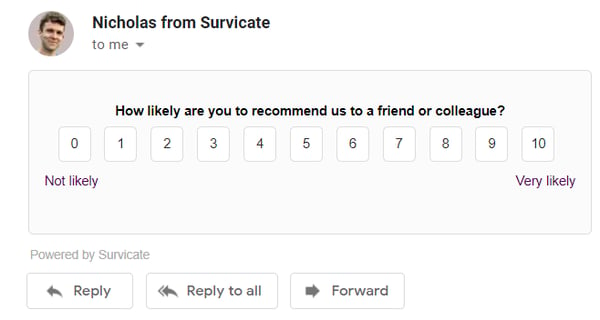
|
TIP: It’s best to use a professional NPS survey tool for this purpose because it will maximize your response rates. The more responses, the more reviews. |
Promoters are the customers who answered with a nine or 10 to the question, “How likely are you to recommend us to a friend?” They are fans who have put their hands up and said that they are ready to tell others about how awesome your business is. The next step is making it easy for them to do so.
It’s best to ask promoters for a review right after they answer the NPS question. To do this, you can just add a second step in the NPS survey including a link to your profile on an online review platform. Make sure your survey tool allows you to use conditional logic to ensure that only your promoters get to see the second step of the survey.
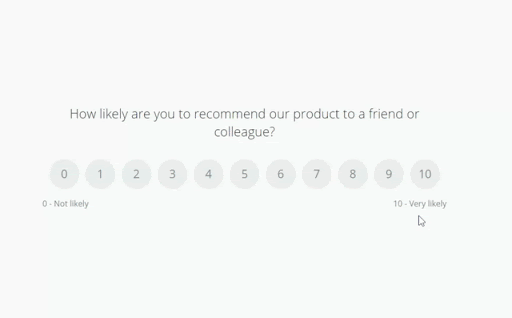
The easiest way to follow up is to first send the NPS survey responses to your CRM or marketing automation software.

From there you can send them reminders using an automated email sequence, for example.
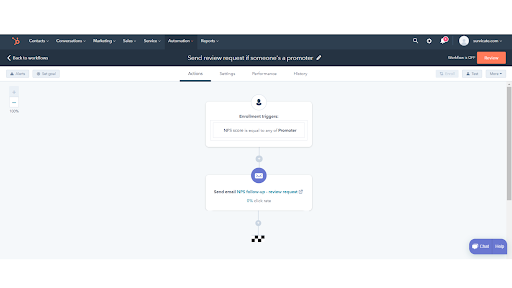
You will receive more reviews if you offer a reward for submitting a review. Gift cards at online retailers make a great choice. However, as a word of caution: these are your most engaged users and they can feel offended if you seem to be buying their trust. Therefore, the message needs to be soft and really positioned as an optional token of your gratitude.
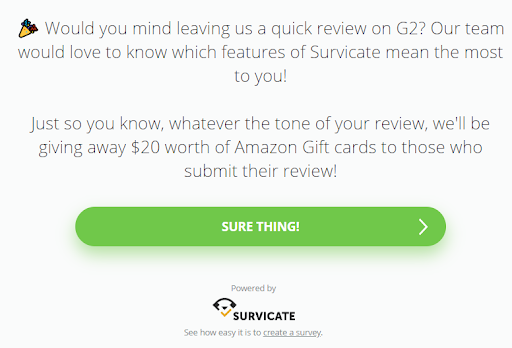
There are many survey tools out there, however, not all of them are optimized to run surveys for businesses. For a business, every customer and every response matters, especially in the NPS survey and review process. Each response can mean an additional customer review. The following survey tool features are made to deliver results for businesses:
This feature lets you personalize the second step of the survey based on what your customers answered in the first step. You can add the second step of the survey only for your promoters, or you can change the message for other respondents. Asking promoters for a review right away increases the chance of them writing one.
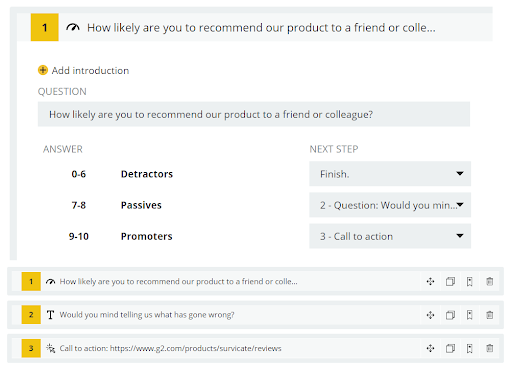
This feature lets you access survey data even for surveys that have not been fully completed. Since you’ll be asking for a review on the second step of the survey, some users may close the survey at this step. You want the data from the first step to still be saved and sent into your CRM or marketing automation so you can follow up by email or other channels. Following up increases the chances of getting online reviews.
This is a huge time saver. Native integration means that with one click, your survey tool is connected to your other tools. A good start is to connect your NPS responses to your email tool. This will allow you to easily send email reminders to those promoters who did not leave a review after they completed the NPS survey.
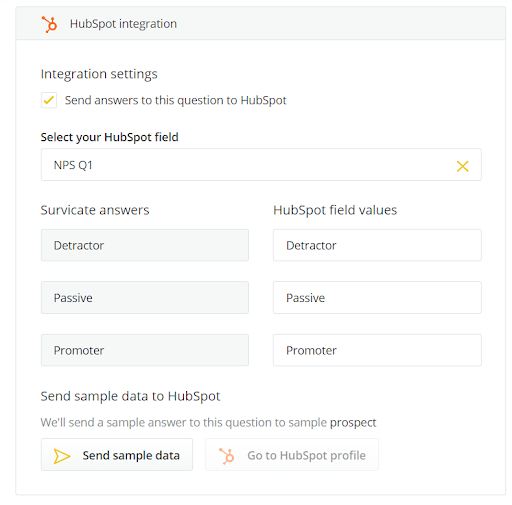
Before investing time and resources into accelerating customer reviews, any marketer would want to make sure they actually make an impact on our customer acquisition efforts.
Well, the proof is in customer reviews statistics. Research indicates that about 95% of shoppers read online reviews before making a purchase, 72% of customers don't take action until they have read reviews, and 84% of people trust reviews they read online as much as personal recommendations.
It’s safe to say that online customer reviews are the new word-of-mouth, and you should get as many of them as you can. Almost all new customers will check your reviews against your competition, so being “more” and “better” recommended equals winning new business.
Using an NPS survey not only boosts your number of reviews but your review score as well. The score tends to be higher since it’s mostly happy customers who are vouching for your business.
Some marketers are still unaware that it’s possible to link NPS score with online customer reviews and, ultimately, with customer acquisition.
They’re shocked when they realize that within one day, it’s possible to implement a process that could boost monthly customer reviews by 1600%. That’s a huge, profitable increase—so why is the NPS survey still not widely used in a marketer’s toolkit?
When Fred Reichheld introduced the Net Promoter Score (NPS) in 2003, it was perceived as a way of managing customer loyalty. To this day, NPS is mostly used by customer success teams and product teams, and not by marketing teams. In other words, it’s used more as a customer retention tool rather than a customer acquisition tool.
It’s 2019, and even the Wikipedia definition of NPS presents it as a “tool that aims to measure the loyalty that exists between a provider and a consumer” and “an alternative to traditional customer satisfaction research.”
Basically, the way the NPS survey is branded and described has created unawareness among marketers in regards to its full potential as a customer acquisition and online reputation management tool.
Buyer behavior has massively changed since 2003 when NPS was introduced. Since then, online shopping has boomed, and with it, the importance of online customer reviews for gaining new business has skyrocketed. This is another good reason for marketers to start paying attention to the NPS survey.
The internet was still young in 2003. Back then, only 10% of the global population was online. In 2019, 60% of the world population has access to the internet, and this number is steadily growing.
More people with internet access means more people who shop online. And more people shopping online means more people using customer reviews in their buying decisions.
By now, you know the best way for a business to get more online reviews and influence the buyer decision in its favor: running an NPS survey and asking promoters for online reviews using the process described above.
Over two-thirds of Fortune 1000 companies are using the NPS survey, so there’s a chance that NPS data already exists inside your company. Ask your product and customer success teams—they’ve been using it for over 15 years.
It’s about time that businesses and marketing teams in particular start connecting the dots between the NPS survey, customer reviews, and customer acquisition. When you choose between two products, aren’t you inclined to choose the one with more or better reviews? So are your customers.
George is the marketing director at Survicate, a survey and customer feedback platform for businesses. George loves all things marketing, and copywriting holds a special space in his heart. On a personal level, he collects guitars and is super passionate about cooking. He can make you scrambled eggs in 4 styles: English, American, French, and Polish! George is active on LinkedIn and you can connect with him there.
You've landed on this page because you're eager to switch up and make your customer onboarding...
 by Rahul Sridhar
by Rahul Sridhar
Customer reviews should be monumentally important to you for one reason: they’re important to...
 by Mike O'Brien
by Mike O'Brien
Loyal customers weave a story for your business that no other stakeholder can.
 by Dwayne Charrington
by Dwayne Charrington
You've landed on this page because you're eager to switch up and make your customer onboarding...
 by Rahul Sridhar
by Rahul Sridhar
Customer reviews should be monumentally important to you for one reason: they’re important to...
 by Mike O'Brien
by Mike O'Brien


